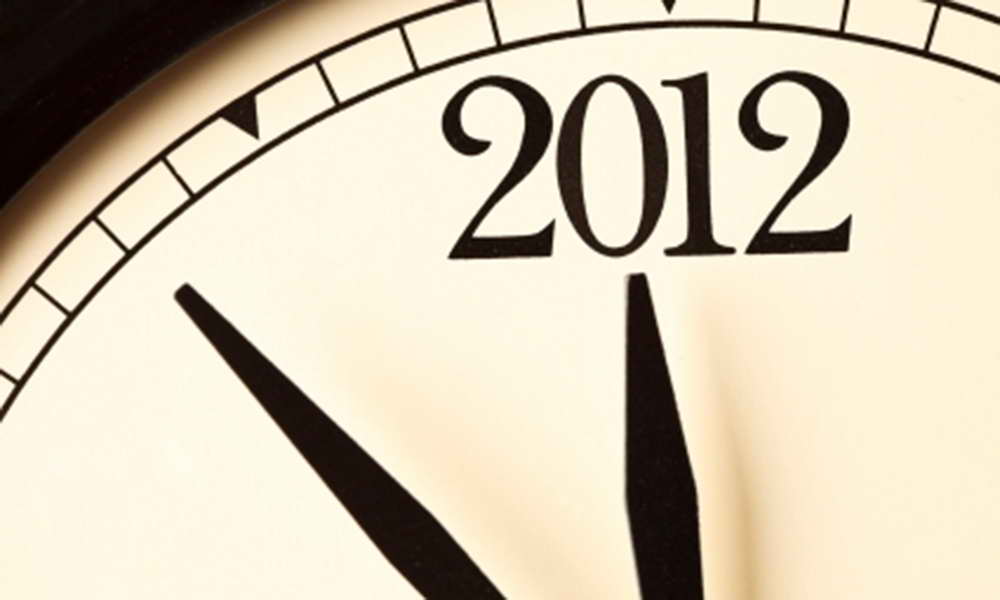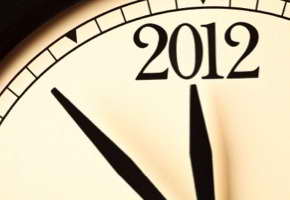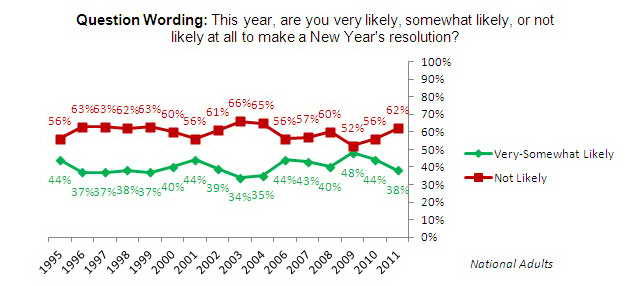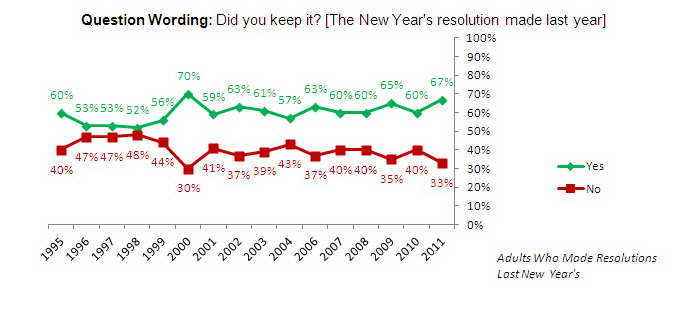December 29, 2011
12/29: Younger Americans Twice as Likely to Make New Year’s Resolution
Nearly six in ten Americans younger than 45 years old — 59% — think they are likely to make a New Year’s resolution for 2012. This compares with just 28% of those 45 and older.
Click Here for Complete December 29, 2011 USA Marist Poll Release and Tables
When further broken down by age, nearly two-thirds of Americans under 30 years old — 64% — believe they will make a New Year’s resolution. A majority — 55% — of those between 30 and 44 say they will do the same. 37% of residents 45 to 59 years old and 23% of those 60 and older plan to alter an aspect of their life.
Is there a gender gap? Similar proportions of women — 40% — and men — 36% — report they will make a New Year’s resolution going into 2012.
Looking at the population overall, 62% of adults nationally say they don’t plan to make a resolution going into the new year while 38% say they will make a New Year’s resolution.
This is the largest proportion of U.S. residents who say they are not going to make a resolution since 2004. At that time, nearly two-thirds — 65% — reported they were not going to resolve to change.
Last year, a majority — 56% — did not plan to make a resolution while 44% did.
Table: Likelihood of Making Resolution
Table: Likelihood of Making Resolution (Over Time)
Combating the Battle of the Bulge Tops List of New Year’s Resolutions
Weight loss is the top New Year’s resolution this year. Nearly one in five Americans who are likely to make a resolution — 18% — say they want to drop a few pounds. Exercise — 11% — comes in next followed by spending less money and saving more — 9%. The resolution to stop smoking, which was last year’s top resolution, also received 9% as did the overall goal of being a better person. 44% plan to make some other type of resolution.
Last year, quitting smoking — 17% — and weight loss — 16% — were the most cited resolutions followed by spending less and saving more with 13%, being a better person with 10%, and exercising more with 8%. 36%, at that time, offered a different resolution.
Women and men are on the same page. 18% of women and 17% of men are resolving to shed a few pounds. However, older Americans — 23% of those 45 and older — are more likely than younger residents — 12% of those younger than 45 — to promise to lose weight. In fact, among younger Americans who are likely to make a resolution, 13% want to save more and spend less.
Table: Top New Year’s Resolutions
Table: Complete List of New Year’s Resolutions
Two-Thirds Kept Resolution This Year
Among those who made a New Year’s resolution going into 2011, 67% report they kept their word for at least part of the year while 33% did not.
Table: Kept Resolution? (Over Time)
Increased Pessimism about the Future
While a majority of Americans say they are optimistic about the world in 2012, there is increased pessimism. Currently, 54% are positive about the future while 43% are not, and 3% are unsure. Last year, six in ten — 60% — had an optimistic outlook while 38% had a pessimistic one, and 2% were unsure.
There is a growing pessimism among men. 48% have an upbeat view about the future while 49% do not. In 2010, nearly six in ten men — 58% — reported an optimistic attitude compared with 39% who were more pessimistic.
Those under 45 years old — 67% — are more optimistic compared with their older counterparts — 48%.




